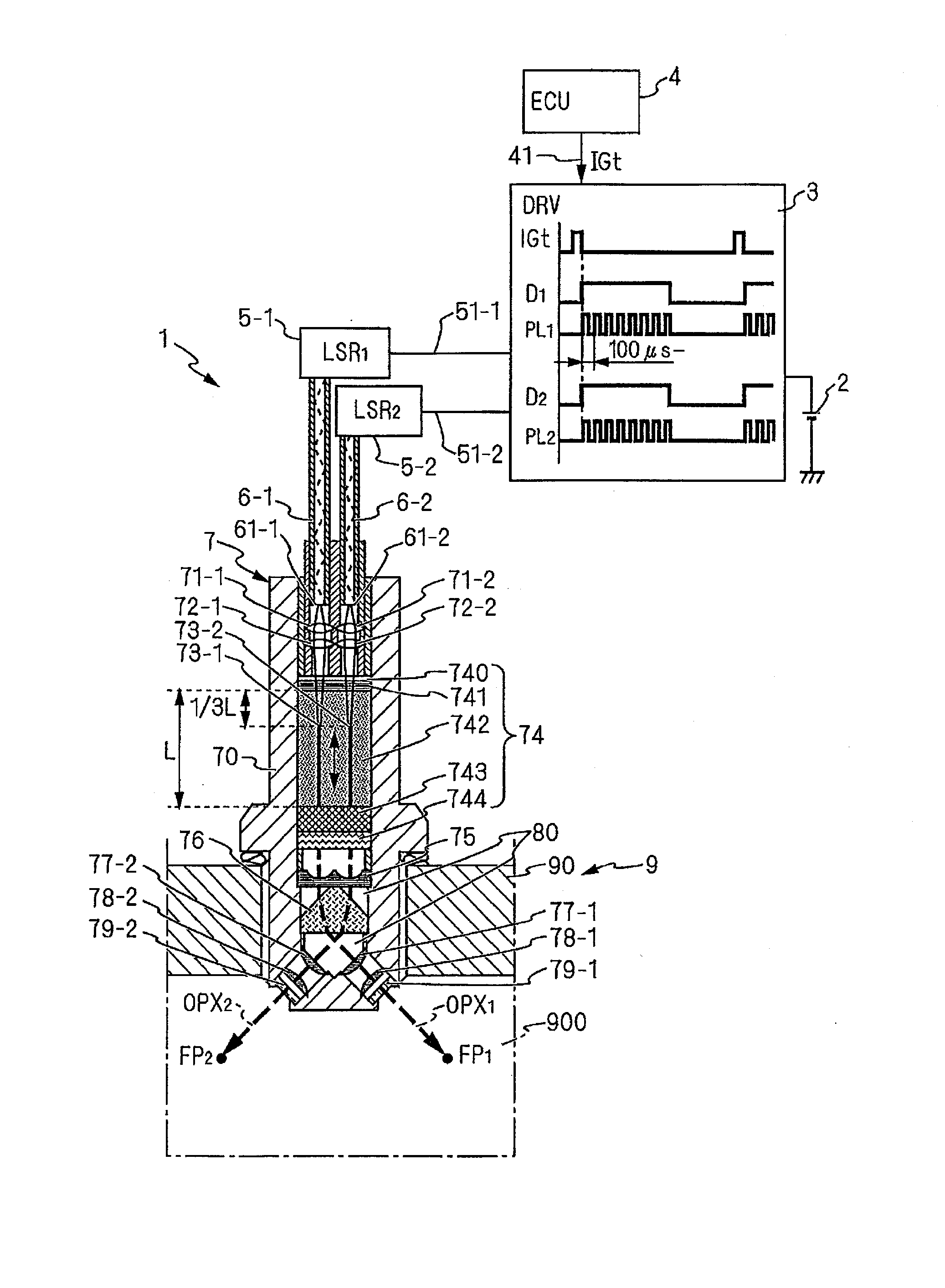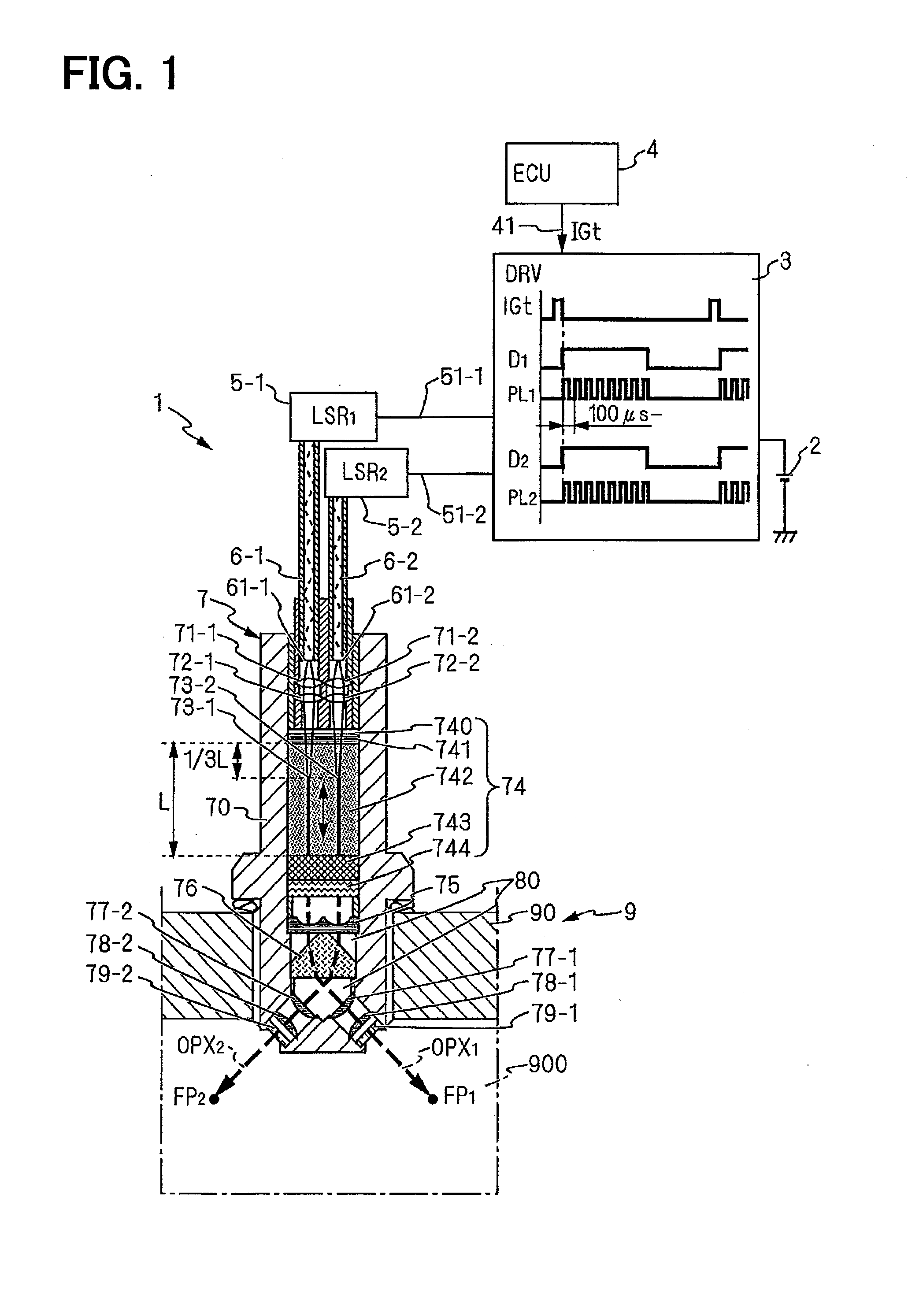Laser ignition system
a laser beam and ignition system technology, applied in the direction of electric ignition installation, mechanical equipment, machines/engines, etc., can solve the problems of reducing the number of molecules which can absorb laser beams, degrading ignition performance, and reducing the absorption of laser beams, so as to enhance the ignition performance of internal combustion engines and reduce size , the effect of simple configuration
- Summary
- Abstract
- Description
- Claims
- Application Information
AI Technical Summary
Benefits of technology
Problems solved by technology
Method used
Image
Examples
first embodiment
[0045]The configuration and operation of a laser ignition system 1 according to a first embodiment of the invention will be described with reference to FIGS. 1 and 2. The laser ignition system 1 according to the first embodiment is an ignition system that is mounted on a cylinder head 90 of an internal combustion engine 9 not drawn and that greatly refracting optical axes OPX1 and OPX2 of plural laser beams by using a highly-refractive optical element 76, condenses the laser beams on plural condensing points FP1 and FP2 in an engine combustion chamber 900, generates flame kernels at plural positions in the engine combustion chamber 900 to ignite a gaseous mixture. Particularly, use for ignition of an ignition-retardant highly-supercharged engine, a highly-compressed engine, a thin gaseous mixture engine, and the like is assumed.
[0046]The laser ignition system 1 includes a power source 2, a semiconductor laser driving circuit (DRV) 3, an engine ECU 4, plural semiconductor lasers 5-1 ...
second embodiment
[0071]A laser ignition system le according to a second embodiment of the invention will be schematically described with reference to FIG. 8. The configuration in which the laser beams exiting from the resonator 74 are expanded by the beam expander 75 and are refracted by the highly-refractive optical element 76 is described in the above-mentioned embodiment, but a configuration in which laser beams exiting from the resonator 74 are refracted by a highly-refractive optical element 76e, are then expanded once by beam expanders 75e-1 and 75e-2, and are additionally condensed by condenser lenses 77e-1, 77e-2, 78-1 and 78-2 may be employed as shown in FIG. 8. At this time, parts of the beam expanders 75e-1 and 75e-2 may be cut to form a petal-like shape and may be intensively unified, like the condenser lenses 77-1 and 77-2 shown in FIGS. 5A to 5C and FIGS. 6A to 6D.
[0072]The condenser lenses 77e-1 and 77e-2 in this embodiment are not unified unlike the above-mentioned embodiment, but a...
third embodiment
[0073]A laser ignition system according to a third embodiment of the invention will be schematically described with reference to FIGS. 9A and 9B. The configuration in which the beam expander 75 and the highly-refractive optical element 76 are separately formed is described in the above-mentioned embodiment, but this embodiment is different from the above-mentioned embodiment in that, as a highly-refractive optical element 76f, concave face portions 751f- 1751f-2 are formed on the exit face of the highly-refractive optical element 76f as shown in FIG. 9B, and a part of the highly-refractive optical element 76f also serves as the beam expander 75. The optical axes OPX1 and OPX2 of the laser beams entering the entrance faces 761f-1 and 761f-2 at an incidence angle θ1 are refracted by a refraction angle θ2 and the laser beams are expanded when exiting from the concave face portions 751f-1 and 751f- 2. The same advantages as in the above-mentioned embodiment are achieved in this embodim...
PUM
 Login to View More
Login to View More Abstract
Description
Claims
Application Information
 Login to View More
Login to View More - R&D
- Intellectual Property
- Life Sciences
- Materials
- Tech Scout
- Unparalleled Data Quality
- Higher Quality Content
- 60% Fewer Hallucinations
Browse by: Latest US Patents, China's latest patents, Technical Efficacy Thesaurus, Application Domain, Technology Topic, Popular Technical Reports.
© 2025 PatSnap. All rights reserved.Legal|Privacy policy|Modern Slavery Act Transparency Statement|Sitemap|About US| Contact US: help@patsnap.com



